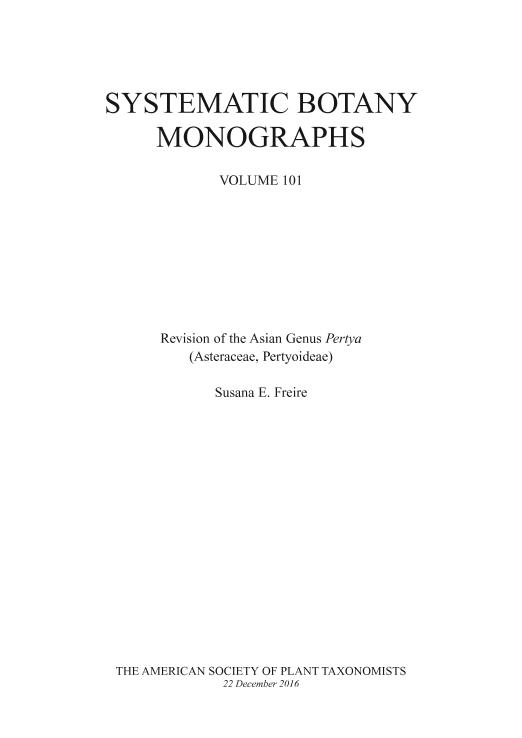Mostrar el registro sencillo del ítem
dc.contributor.author
Freire, Susana Edith

dc.date.available
2017-12-04T17:52:45Z
dc.date.issued
2016-12
dc.identifier.citation
Freire, Susana Edith; Revision of the genus Pertya (Asteraceae, Pertyoideae); American Society of Plant Taxonomists; Systematic Botany Monographs; 101; 12-2016; 1-90
dc.identifier.isbn
978-1-943751-01-3
dc.identifier.issn
0737-8211
dc.identifier.uri
http://hdl.handle.net/11336/29582
dc.description.abstract
Pertya Sch. Bip. (Asteraceae: Pertyoideae: Pertyeae) is an Asiatic genus, ranging from Afghanistan to Japan. Pertya comprises 22 species of small shrubs: 16 species are endemic to China, one to Japan, one to China and Japan, one to Thailand, one to Taiwan, one to Afghanistan, and one to Afghanistan and Pakistan. It is characterized by having macroblasts and brachyblasts bearing alternate and congested leaves, respectively. Pertya yakushimensis is synonymized with P. glabrescens. One new combination is proposed: Pertya dioica (Bunge) S. E. Freire. Three series previously recognized are raised to sectional rank: Pertya sect. Pertya, P. sect. Phylicoides, and P. sect. Sinensis. Pertya sect. Eupertya ser. Paniculatae is newly synonymized with Pertya sect. Phylicoides. The cladistic relationships of the genus, based on analysis of 36 morphological characters, were investigated. Catamixis, Ainsliaea, Macroclinidium, and Myripnois, the genera closest to Pertya, were included as part of the in-group, and Oldenburgia, from South Africa, was used as the out-group for phylogenetic analysis. Pertya is distinguished from Ainsliaea by its barbellate pappus setae (vs. plumose in Ainsliaea), and from Macroclinidium and Catamixis principally by its heterothalamic habit (vs. homothalamic in Macroclinidium and Catamixis). The phylogenetic analysis resulted in seven most parsimonious trees (MPTs), each of 111 steps. The genus Pertya, as currently recognized, is shown to be paraphyletic. However, if the monotypic genus Myripnois is included, Pertya is monophyletic. Cladistic analysis supports the reduction of the genus Myripnois into the synonymy of Pertya. The cladistic relationships within Pertya are consistent with the three sections proposed here: Pertya, Phylicoides, and Sinensis. A key to the species of the genus is provided, as well as morphological descriptions, illustrations, and distribution maps
dc.format
application/pdf
dc.language.iso
eng
dc.publisher
American Society of Plant Taxonomists

dc.rights
info:eu-repo/semantics/openAccess
dc.rights.uri
https://creativecommons.org/licenses/by-nc-sa/2.5/ar/
dc.subject
Compositae
dc.subject
East-Asian
dc.subject
Myripnois
dc.subject
Phylogeny
dc.subject.classification
Ciencias de las Plantas, Botánica

dc.subject.classification
Ciencias Biológicas

dc.subject.classification
CIENCIAS NATURALES Y EXACTAS

dc.title
Revision of the genus Pertya (Asteraceae, Pertyoideae)
dc.type
info:eu-repo/semantics/article
dc.type
info:ar-repo/semantics/artículo
dc.type
info:eu-repo/semantics/publishedVersion
dc.date.updated
2017-07-05T18:15:22Z
dc.journal.volume
101
dc.journal.pagination
1-90
dc.journal.pais
Estados Unidos

dc.description.fil
Fil: Freire, Susana Edith. Consejo Nacional de Investigaciones Científicas y Técnicas. Instituto de Botánica Darwinion. Academia Nacional de Ciencias Exactas, Físicas y Naturales. Instituto de Botánica Darwinion; Argentina
dc.journal.title
Systematic Botany Monographs
Archivos asociados
